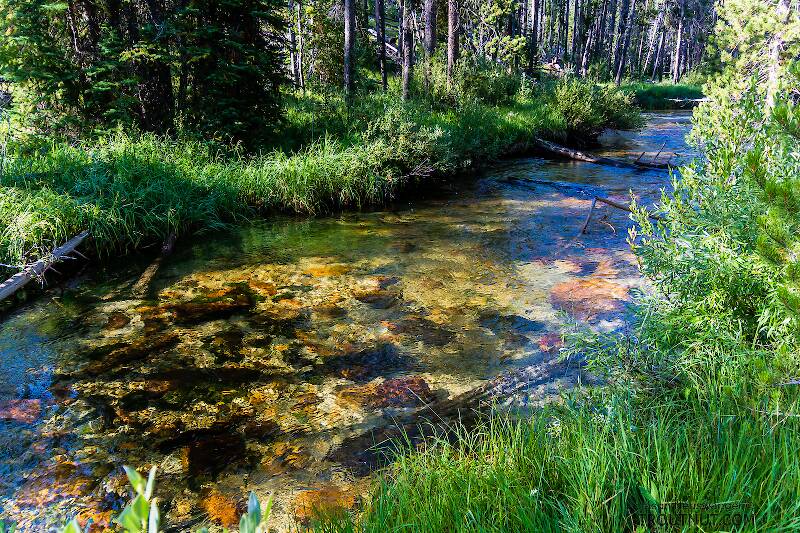
Hex Mayflies
Hexagenia limbata
The famous nocturnal Hex hatch of the Midwest (and a few other lucky locations) stirs to the surface mythically large brown trout that only touch streamers for the rest of the year.

- The prosternal horn is present.
- The mandible is clearly toothed, not formed into a uniform scraper blade.
- The seems to be only 2 major setae on the ventral edge of the hind femur.
- Chloride epithelia seem to be absent from the dorsal side of any abdominal segments.
Based on these characteristics and the ones more easily visible from the pictures, this seems to be Grammotaulius. The key's description of the case is spot-on: "Case cylindrical, made of longitudinally arranged sedge or similar leaves," as is the description of the markings on the head, "Dorsum of head light brownish yellow with numerous discrete, small, dark spots." The spot pattern on the head is a very good match to figure 19.312 of Merritt R.W., Cummins, K.W., and Berg, M.B. (2019). The species ID is based on Grammotaulius betteni being the only species of this genus known in Washington state.

Mayfly Species Caenis amica (Angler's Curses)
Where & when
This hatch occurs across the country. Fred Arbona reports in Mayflies, the Angler, and the Trout that it precedes the Tricorythodes hatch in the East and Midwest.In 97 records from GBIF, adults of this species have mostly been collected during June (30%), July (29%), August (21%), May (13%), and September (5%).
In 47 records from GBIF, this species has been collected at elevations ranging from 295 to 5791 ft, with an average (median) of 3314 ft.
Species Range
Physical description
Most physical descriptions on Troutnut are direct or slightly edited quotes from the original scientific sources describing or updating the species, although there may be errors in copying them to this website. Such descriptions aren't always definitive, because species often turn out to be more variable than the original describers observed. In some cases, only a single specimen was described! However, they are useful starting points.
Male Spinner
Wing length: 2 mm
Allied to Caenis diminuta, but the black apical mark on the middle and hind femora is a streak only, not a band.
Head fulvous; with black bands. Antennae white. Prothorax fulvous, banded with black; mesothorax brassy fulvous. Legs whitish, the fore legs much longer; cinereous, the femora obscurer; middle and hind femora with a black spot above upon the apex, this spot not continued downward to form a band, as in C. diminuta; on the outer side of the trochanter is a black streak. Wings semi-hyaline, whitish-grey, “the two costal veins black” (Hagen). Abdomen pale; tergites shaded with grey, the posterior margins and the sides marked with black. Tails white. Forceps short, much as in diminuta, but somewhat more curved than in the latter species, and the tips more finely pointed (see Pl. XXXIX).
Distinguished from C. diminuta by the lack of an entire black band on the hind femora, by the brighter brown of the mesonotum, and the black streak on the trochanter.
Described as C. simulans
Body length 3.5-4 mm, wing length 3.5-4 mm
A species with forceps of moderate length; mesonotum bronzy-brown; head blackish. See frontispiece.
Head entirely suffused with blackish above; eyes black, antennae pale. Pronotum pale yellowish; median area and antero-lateral margin strongly suffused with blackish; margins narrowly black. Mesonotum bronzy-brown, darker than in C. jocosa (now a synonym of Caenis latipennis); scutellum paler, faintly shaded with black. Metanotum pale shaded with black. Pleura bronzy-brown, paler around the bases of the legs; a few faint black streaks; a fine black line on the anterior margin. Sternum light yellowish. Fore legs with blackish shading at the bases; femora blackish, with a mere trace of a dark apical spot; tibiae and tarsi faintly smoky. Middle and hind legs pale yellowish; slight black dots and streaks on coxa and trochanter; dorso-apical black streak on femur fainter than in jocosa. Wings hyaline whitish; subcosta and radius purplish.
Abdominal tergites pale yellowish, shaded with black as in C. jocosa; black stigmatic dots on segments 1-7; a broken black mid-dorsal line on the first two or three tergites; tergites 8 and 9 deeper yellowish, with traces of a dark median dot on 9 and dark median longitudinal streaks on 10. Sternites pale; a pair of obliquely arranged dark dots on sternites 6-8; faint black lateral dashes on the basal sternites; and a small round brownish mid-ventral spot on each segment. Forceps faintly smoky; tails pale. Forceps of moderate length, distinctly curved, and slightly thicker than in C. jocosa (see Pl. XXXIX). This species, allied to C. jocosa, may be distinguished from it by the larger size, lack of black spots on the pronotum, presence of brownish mid-ventral spots, darker mesonotum and more curved forceps.
The species appears to be quite variable as to markings, dark forms having faint black lateral dashes on tergites 8-10; in some, the mid-ventral spots may be wanting. Western specimens which seem to belong here are somewhat larger than the eastern ones, with darker mesonotum and wider-spread blackish suffusion of the tergites.
Start a Discussion of Caenis amica
References
- Arbona, Fred Jr. 1989. Mayflies, the Angler, and the Trout. Nick Lyons Books.
- Caucci, Al and Nastasi, Bob. 2004. Hatches II. The Lyons Press.
- Knopp, Malcolm and Robert Cormier. 1997. Mayflies: An Angler's Study of Trout Water Ephemeroptera . The Lyons Press.
- Leonard, Justin W. and Fannie A. Leonard. 1962. Mayflies of Michigan Trout Streams. Cranbrook Institute of Science.
- Merritt R.W., Cummins, K.W., and Berg, M.B. 2019. An Introduction to the Aquatic Insects of North America (Fifth Edition). Kendall/Hunt Publishing Company.
- Needham, James G., Jay R. Traver, and Yin-Chi Hsu. 1935. The Biology of Mayflies. Comstock Publishing Company, Inc.
Mayfly Species Caenis amica (Angler's Curses)
Species Range
Resources
- NatureServe
- Integrated Taxonomic Information System
- Global Biodiversity Information Facility
- Described by Hagen (1861)

